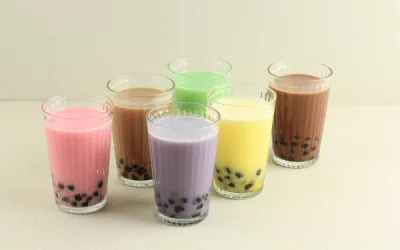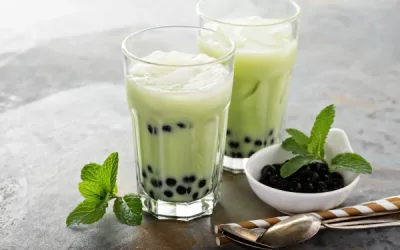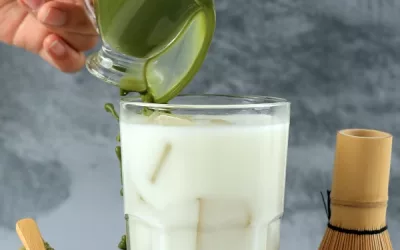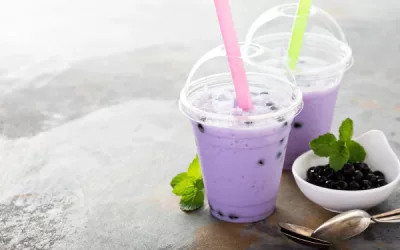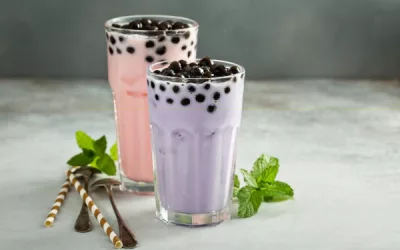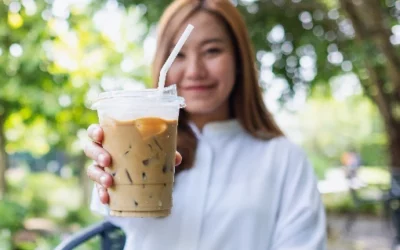Have you ever wondered why bubble tea has taken the world by storm? With its delightful mix of flavours and textures, bubble tea—primarily the various boba flavours—has captured the hearts of countless enthusiasts. This guide will delve into the vibrant universe of boba, from the most popular flavours to DIY recipes and vegan options, helping you discover your perfect brew. Get ready to elevate your bubble tea game and explore the possibilities that await behind each unique flavour!
Table of Content
- What are the most popular boba flavours?
- How can I make bubble tea at home?
- What ingredients do I need for making bubble tea?
- Are there any vegan options for bubble tea?
- What is the difference between tapioca pearls and popping boba?
- What are some unique boba flavour combinations?
- How do I choose the right bubble tea shop?
- What trends are emerging in the boba tea industry?
- Conclusion
What are the most popular boba flavours?
Boba tea, also known as bubble tea, has captured the hearts of many around the world. With an array of flavours to choose from, it’s no wonder people keep coming back for more. Some boba flavours have risen to popularity due to their unique taste and appealing aesthetic. Let’s explore the most popular boba flavours, including classic and trending options like mango, taro, matcha, strawberry, and brown sugar.
What makes these flavours popular?
These flavours have made a name for themselves in the bubble tea community for good reasons. Here’s why:
- Mango: Bursting with tropical sweetness, it’s refreshing and vibrant, making it a summer favourite.
- Taro: With its creamy texture and subtle sweetness, taro offers a comforting and unique taste that stands out.
- Matcha: Rich in antioxidants, matcha provides an earthy and slightly bitter flavour that balances well with the sweetness of boba.
- Strawberry: Sweet and slightly tart, strawberry boba is visually appealing and delightful to taste.
- Brown Sugar: Known for its caramel-like flavour, brown sugar boba has a rich and indulgent taste that’s hard to resist.
These flavours are popular because they appeal to a wide range of taste preferences and create a memorable drinking experience.
How do these flavours differ from each other?
Each of these boba flavours brings something unique to the table. Let’s break it down:
- Mango:
- Tropical and fruity
- Bright yellow colour
- Refreshing and sweet
- Taro:
- Creamy and smooth
- Purple hue
- Subtle and nutty sweetness
- Matcha:
- Earthy and slightly bitter
- Green colour
- Rich in antioxidants
- Strawberry:
- Sweet and tart
- Pinkish-red hue
- Fruity and refreshing
- Brown Sugar:
- Caramel-like sweetness
- Brown and golden swirls
- Rich and indulgent
These differences make each flavour a distinct experience. Whether you’re in the mood for something fruity, creamy, or indulgent, there’s a boba flavour for you.
Are there any seasonal flavours to consider?
Yes, many boba shops offer seasonal flavours. These flavours add a festive touch and often incorporate seasonal fruits and ingredients. Some examples include:
- Pumpkin Spice: A popular autumn flavour, perfect for those who love the taste of pumpkin pie.
- Peppermint: Often available during the winter holidays, it adds a cool and refreshing twist.
- Lychee: A summer favourite, it’s light, floral, and perfect for hot weather.
- Watermelon: Another summer choice, it’s hydrating and delicious.
Boba shops often experiment with flavours based on seasonal produce and holidays, making sure there’s always something new to try.
During the 1980s in Taiwan, a small tea shop in Taichung experimented by adding tapioca pearls to their iced tea. This innovation led to the creation of bubble tea. The shop’s unique drink quickly gained popularity, leading to the global phenomenon we see today.
That shop’s name was Chun Shui Tang, and it remains a popular destination for boba enthusiasts.
I remember my first encounter with bubble tea. It was a warm summer day, and I stumbled upon a small boba shop in London. Curious, I ordered a mango bubble tea. The first sip was a burst of tropical sweetness, complemented by the chewy tapioca pearls.
That refreshing experience marked the beginning of my love for bubble tea, and I’ve since become a bubble tea enthusiast, always eager to try new flavours and seasonal specials.

How can I make bubble tea at home?
Making bubble tea at home is a fun and rewarding experience. You can customise flavours, adjust sweetness, and even choose the type of milk or tea that suits your taste buds. The process is straightforward once you gather the necessary ingredients and tools.
Here is a comprehensive table that outlines everything you’ll need and the steps to follow.
The table below will guide you through the process of making bubble tea at home. The first column lists the ingredients and tools, the second column provides a brief description of each, and the third column explains its purpose in the recipe.
| Ingredient/Tool | Description | Purpose |
|---|---|---|
| Tapioca pearls | Small, chewy balls made from tapioca starch | The “boba” in bubble tea |
| Black tea leaves | Dried leaves from the Camellia sinensis plant | The base flavour of the tea |
| Sugar syrup | Combination of sugar and water | Sweetens the tea |
| Milk or dairy substitute | Cow’s milk, almond milk, soy milk, etc. | Adds creaminess to the tea |
| Ice cubes | Frozen water | Cools and dilutes the tea |
| Large straw | Wide straw | Allows the tapioca pearls to pass through |
| Pot | Deep vessel | Boils the tapioca pearls |
| Tea infuser or strainer | Tool to hold loose tea leaves | Filters the tea leaves out of the brewed tea |
| Shaker | Container to mix ingredients | Ensures even distribution of flavours |
To use the table, simply gather the listed ingredients and tools, then follow the step-by-step instructions provided. This will help you master the art of creating delicious bubble tea right from your kitchen.
What are some popular boba flavours?
Exploring boba flavours can be an exciting adventure. From fruity to creamy, there are numerous options to try. Here are some popular flavours you might want to consider:
- Classic Milk Tea: A blend of black tea, milk, and sugar. This is the quintessential boba flavour.
- Taro: Made from taro root, it has a sweet, nutty flavour and a distinctive purple colour.
- Matcha: A green tea powder that offers a strong, slightly bitter taste balanced by milk and sweetener.
- Lychee: A tropical fruit flavour that’s sweet and fragrant, often paired with green or black tea.
- Mango: A refreshing, fruity option that’s perfect for warm weather.
Each flavour has its unique attributes, making it fun to experiment and find your favourite.
What variations of boba toppings can I add?
Boba tea is not just about the flavours; toppings play a crucial role too. Here are some popular options to enhance your bubble tea experience:
- Popping Boba: Fruit juice-filled pearls that burst in your mouth.
- Aloe Vera: Small, chewy pieces of aloe that add a refreshing touch.
- Grass Jelly: A herbal jelly that offers a slightly bitter and subtly sweet flavour.
- Red Bean: Sweetened red beans that add a rich, creamy texture.
- Pudding: Soft, custard-like consistency that adds a smooth texture to the drink.
Adding these toppings can elevate your boba tea to the next level, making each sip a delightful experience.
In Taiwan during the 1980s, bubble tea emerged as a novel beverage, blending tea with milk and tapioca pearls. At that time, a tea house owner named Lin Hsiu Hui experimented by adding sweetened tapioca balls into iced tea, creating an instant hit.
This innovation quickly spread across Asia and then globally, bringing joy to millions of tea enthusiasts. It’s fascinating how a simple idea can revolutionise the way we enjoy our beverages.
I remember my first attempt at making bubble tea at home. I had gathered all the ingredients and was excited to replicate my favourite drink. As I boiled the tapioca pearls and brewed the tea, my kitchen filled with a delightful aroma.
Although I made a mess, the final product was worth it. The satisfaction of sipping on a homemade bubble tea, perfectly customised to my taste, was unparalleled. It became a fun ritual, and now, every time I make it, I’m reminded of that first joyful experiment.
What ingredients do I need for making bubble tea?
Alright, so you’ve decided to make bubble tea at home. Good choice! No need to queue in long lines or spend heaps of money anymore. Let’s break it down so you can be your own bubble tea barista.
First things first, you need some basic ingredients: tea, milk, sweeteners, flavour syrups, and of course, the renowned tapioca pearls (a.k.a. boba). Now, let’s take a closer look at each one.
What are the best types of tea for bubble tea?
Step up your tea game, my friend! Not all teas are created equal when it comes to bubble tea. Here’s what you should know:
- Black Tea: The classic choice. Rich, bold, and often combined with milk. Think of it as the Sherlock Holmes of teas, solving all flavour-related mysteries.
- Green Tea: Light, refreshing, and somewhat grassy. Perfect if you’re into a subtler drink that makes you feel like you’re sipping springtime.
- Jasmine Tea: A floral option that adds an aromatic twist. It’s like drinking a garden in a cup.
- Oolong Tea: Somewhere between black and green, this one’s earthy and complex. Ideal if you’re having an indecisive day.
- Matcha: Bright green and powdery. It’s as energising as it looks and gives your bubble tea a quirky edge.
Choosing the right tea will set the foundation for your bubble drink, so pick wisely!
Can I use non-dairy alternatives?
Lactose-intolerant? Plant-based? Just not a fan of cow’s milk? No worries, there are plenty of non-dairy options:
- Almond Milk: Nutty and slightly sweet. Adds a lovely texture and taste without overpowering the tea.
- Soy Milk: Creamy and rich, closely resembling regular milk. Soy is like the undercover agent, blending into any drink it wishes.
- Oat Milk: Buttery and naturally sweet. This one’s a crowd-pleaser even if you’re not avoiding dairy.
- Coconut Milk: Exotic and fragrant. Ideal if you want to pretend you’re on a tropical island instead of slogging away at your 9-to-5.
- Rice Milk: Thin and sweet. Good for a lighter bubble tea that won’t weigh you down.
So yes, you can absolutely use non-dairy milk, and frankly, you’ll barely notice the difference.
How do I choose the right sweetener?
Nobody likes a bland bubble tea. Sweeteners are like the cherry on top – but you’ve got options:
- Sugar Syrup: The classic and simple choice. Dissolves easily and isn’t fussy.
- Brown Sugar: Adds a caramel-like depth. Brown sugar boba anyone? Yes, please!
- Honey: Natural and floral. Good for adding a healthier touch.
- Agave Syrup: Vegan and less intense. Ideal if you want sweetness without the sugar rush.
- Stevia: Low on calories, but still sweet. Ideal for those watching their waistline.
There’s a right sweetener for every drink, and we all know bubble tea wouldn’t be the same without that hint of sweetness.
Let’s not forget flavour syrups and pearls. These babies infuse your drink with that signature taste we all crave. From classic tapioca pearls to mini boba, and from fruity syrups to rich chocolate – the sky’s the limit.
Are there any vegan options for bubble tea?
Bubble tea fans, brace yourselves! There’s good news: vegan options for bubble tea abound (who knew, right?). If you’re the proud owner of a pair of Birkenstocks and a penchant for cruelty-free indulgences, you’re in luck.
With a plethora of plant-based milks, natural sweeteners, and vegan flavourings, you can sip away without a hint of guilt.
Pondering on how to substitute that creamy dairy milk with something plant-based? You’ve got plenty of choices. Plus, there are vegan-friendly boba pearls that look and taste just as fabulous as the regular ones.
But wait, let’s not stop there. Ensuring your bubble tea is entirely vegan requires a bit of caution. Let’s dig deeper and navigate through this frothy world together.
What plant-based milks work best?
First things first, chuck the cow and consider these stellar plant-based dairy substitutes for that luscious creamy consistency. These milks not only bring a top-notch flavour but are also kinder to our bovine buddies. Here’s a go-to list:
- Almond Milk: Light, nutty, and commonly available, almond milk is a favourite among many for its versatility.
- Oat Milk: Creamy without being overpowering, it’s like the comfort blanket of plant milks.
- Soy Milk: Reliable and protein-packed, soy milk offers a rich flavour that complements the tea base well.
- Coconut Milk: If you’re into tropical vibes, this rich and slightly sweet milk brings the beach to your boba.
- Cashew Milk: Ultra-smooth and slightly sweet, cashew milk is an underdog worth considering.
With these options, your bubble tea can have any profile you fancy from light and refreshing to rich and decadent. Just make sure your shop doesn’t sneak in any dairy-based creamers when you request the switch.
Are there vegan-friendly boba pearls?
Good news for you: not all boba pearls are made alike! While traditional pearls are often soaked in honey, there are alternatives that cater to the vegan crew. Check out these options:
- Agar Pearls: Made from seaweed-derived agar, they’re jiggly, satisfying, and plant-based.
- Tapioca Pearls: Traditionally vegan if they stick to tapioca starch and water, but beware of what they’re soaked in.
- Fruit-based Boba: Bursting with flavour and 100% vegan, these pearls are a fruit-fanatic’s dream.
To make life easier, check with your boba tea shop for labels or directly ask the staff about the ingredient list. A quick chat could save your ethical choices from a sugary slip-up.
How can I ensure my bubble tea is fully vegan?
So, you’ve got your milk and pearls sorted, but there’s still a little legwork to do. Ensuring the entirety of your drink is vegan involves more than just the main components. Here’s a quick checklist to make sure you’re in the clear:
- Sweeteners: Opt for natural sweeteners like agave, maple syrup, or simple sugar syrup.
- Flavourings: Stick to natural flavourings free from dairy derivatives such as fruit purees or plant-based flavour extracts.
- Toppings: Choose from vegan-friendly toppings like fruit chunks, aloe vera, or vegan foam (yes, it’s a thing!).
This way, you can relish your bubble tea knowing it aligns perfectly with your vegan values, right down to the last chewy bit and burst of flavour.
Back during the 8th century, tea culture was blossoming in China, largely influenced by the Tang Dynasty. They developed new ways to enjoy tea, particularly appreciating the combination of tea leaves with various flavours and ingredients.
Though they weren’t concocting boba back then, it was this very culture that birthed innovative beverage traditions. The adventurous spirit of tea creation back then paved the way for today’s exciting bubble tea experiments, including our beloved vegan options.
Cheers to history quenching our modern thirst!
What is the difference between tapioca pearls and popping boba?
Ever wondered why your bubble tea has that chewy bounce or sudden burst of flavour? Welcome to the world of tapioca pearls and popping boba! These two stellar ingredients make every bubble tea experience unique.
Let’s break down their differences and what they bring to the tea table.
Tapioca pearls are like the reliable oldies in your playlist. They’re those chewy, dark, and slightly sweet balls that you marvel at whenever you sip your bubble tea. Made from cassava starch, these little pearls are boiled until they’re just the right kind of chewy.
Texture-wise, they’re like tiny gummy bears.
On the other hand, popping boba is the new kid on the block—think bubble wrap candy. These colourful, gelatinous balls pop with a burst of fruity flavour when you bite into them.
Made from seaweed extract, they’re not cooked like tapioca pearls. Instead, they’re formed using a molecular gastronomy trick called spherification. Talk about fancy!
How do they affect the overall bubble tea experience?
- Texture: Tapioca pearls deliver a consistent chewiness, like trying to chew on a firm jelly. Popping boba offers a playful burst, like popping a balloon in your mouth but tastier.
- Flavour: Tapioca pearls start sweet but are often neutral to compliment the tea or milk. Popping boba, however, comes in dizzying flavours like lychee, mango, and strawberry, bringing an unexpected twist.
- Preparation: Tapioca pearls require boiling for a good chunk of time and a bit of sugar to sweeten them up. Popping boba? Just scoop them out of the jar and you’re set. Easy peasy.
- Uses: Tapioca pearls are the classic choice for traditional milk teas, giving that authentic bubble tea feel. Popping boba is a favourite for fruit teas and slushies, making the experience fun and refreshing.
Do these beauties change your bubble tea game? Absolutely. Tapioca pearls deliver a more traditional experience, adding a familiar chewiness. Popping boba, though, spice things up with an explosion of fruity fun.
Which one is more popular?
- Tapioca Pearls: The OG of boba world, beloved for years. They’re comforting and familiar, the backbone of every classic bubble tea experience.
- Popping Boba: Trending among the adventurous and the Instagram-generation. They’re visually appealing and add an exciting element to your drink.
Popularity often depends on the crowd. Traditionalists stick with tapioca pearls, whereas the younger and risk-taking crowd lean towards popping boba for that unexpected burst.
Both have carved out their niche and enjoy a loyal following. The bubble tea landscape is all the richer for it.
Can I mix both in my bubble tea?
- Texture Duality: You get both the chewiness of tapioca pearls and the pop of popping boba. Imagine the party happening in your mouth!
- Flavour Fusion: Combining them can create a layered experience—go ahead, pair that classic milky goodness with a popping fruity surprise.
- Aesthetic Appeal: Mixed boba makes your drink look like a carnival in a cup. Talk about eye candy!
Traditionalists might shake their heads, but mixing both can revolutionise your bubble tea journey. Who says you can’t have the best of both worlds in your cup?
In the Qing dynasty, bubble tea wasn’t even a thing; it’s a true 20th-century marvel. But even back in the day, the creativity in Chinese tea culture was insane.
Take Empress Dowager Cixi, for instance. She had her chefs create over a hundred dishes for each meal to enjoy a variety of flavours. It’s not far off from your adventurous sip of bubble tea with both tapioca pearls and popping boba.
The desire for culinary innovation runs deep!
What are some unique boba flavour combinations?
Let’s be honest, boba has officially taken over the world. It’s like the superhero of drinks, saving us from boring old beverages one tapioca pearl at a time. But while classic flavours like milk tea and taro get all the love, there’s a whole universe of boba flavour combinations out there waiting for you to explore.
Picture this: You’re sipping on a concoction you’ve never tasted before. It’s like a party in your mouth, and everyone’s invited. Why stick to the basics when you could be adventuring into the wild side of boba?
Let’s dive into some unique boba flavour pairings that’ll make your taste buds dance.
Lavender honey
Lavender isn’t just for your grandma’s potpourri. When you mix floral lavender with sweet, sticky honey, you get a sophisticated, aromatic drink that’s both relaxing and delightful. It’s tea meets spa day.
- Lavender – add that subtle, relaxing floral note.
- Honey – brings in the natural sweetness.
- Milk – a splash to round it all out.
- Tapioca balls – because it’s not boba without them.
Fancy yourself a little bit of an aristocrat with this combo.
Matcha red bean
Matcha and red bean? That’s like the dynamic duo of the boba world. Earthy matcha paired with sweet, gooey red bean paste is like yin and yang in your cup. It’s balanced and oh-so satisfying.
- Matcha powder – giving that green goodness.
- Red bean paste – for the sweetened texture.
- Whole milk – to smooth it all together.
- Ice – blend it if you want a frappé-like experience.
Who knew green and red would ever get along so well?
Lychee rose
Lychee and rose are like the Romeo and Juliet of flavours. Exotic lychee’s juicy sweetness complemented by the delicate, romantic notes of rose makes for a fragrant adventure.
- Lychee syrup – for that juicy punch.
- Rose water – just a few drops go a long way.
- Black tea – to deepen the flavours.
- Coconut milk – to enhance the fruitiness.
Living life as a poet? This one’s for you.
Salted caramel
Sweet, salty, and just a little bit naughty. Salted caramel brings a harmonious touch to your cup, blending creamy caramel’s richness with a surprising hint of salt.
- Salted caramel syrup – the star of the show.
- Sea salt – just a pinch.
- Cream – to keep it smooth.
- Coffee – optional, for that extra kick.
Warning: highly addictive and may cause an obsession.
Coconut pandan
Travel to the tropics without leaving your seat. Coconut’s creamy, rich flavour pairs heavenly with pandan’s nutty, vanilla-like taste. This one’s a tropical paradise in a cup.
- Coconut milk – silky and smooth.
- Pandan extract – adds that nutty complexity.
- Brown sugar syrup – for sweetness.
- Tapioca pearls – because chewy is fun!
Just one sip and you’ve got a round-trip ticket to flavour town.
How can I create my own combinations?
Creating your own boba flavours is about unleashing your inner mad scientist. You’ll need a bit of trial and error, but start with these essentials:
- Base: Decide if you want tea, milk, or a fruity base.
- Flavours: Choose two complementary flavours – think sweet and spicy, or fruity and floral.
- Sweetener: Everything tastes better with a bit of syrup or sugar.
- Extras: Tapioca pearls, jellies, or boba – take your pick.
Experiment like you’ve never been wrong before!
What ingredients pair well together?
Pairing ingredients is all about balance. Here’s a cheat sheet to get you started:
- Sweet and Savory: Think caramel and sea salt, or chocolate and chili.
- Earthy and Sweet: Matcha and red bean, or cinnamon and vanilla.
- Fruity and Floral: Lychee and rose, or mango and jasmine.
- Creamy and Nutty: Coconut and almond, or peanut butter and banana.
Trust your instincts, your taste buds know best.
Are there any flavour combinations to avoid?
Not every love story has a happy ending, and the same goes for boba. Some flavours are better off staying single:
- Mint and Milk: Minty fresh milk? Just no.
- Sardine and Strawberry: Don’t ask. Just don’t.
- Onion and Orange: Your palate will never forgive you.
- Garlic and Guava: Not a match made in heavenly kitchens.
You know what they say – some ingredients are better left unacquainted.
Back in the 17th century, tea was an exotic luxury in Europe, traded by the East India Company. Fancy folks would mix it with everything from herbs to fruits, seeking the perfect brew.
This adventurous spirit has lived on, morphing into our current obsession with boba, continuously pushing boundaries with creative flavour pairings. So go on, channel your inner 17th-century tea aficionado and start mixing. Make every sip a historical revolution.
How do I choose the right bubble tea shop?
Choosing the right bubble tea shop can feel like chasing a mythical creature, but it doesn’t have to be that hard. Whether you’re a seasoned bubble tea enthusiast or just curious about the fuss, selecting a shop boils down to a few key factors: menu variety, quality of ingredients, customer reviews, location, and pricing.
Let’s dive into these aspects to ensure you find your perfect boba haven.
Menu variety
A diverse menu is a sign you’ve stumbled upon a bubble tea treasure trove. Look for:
- A wide range of boba flavours: From classic milk tea to exotic fruit blends.
- Varied toppings options: Think beyond just tapioca pearls; what about popping boba, jelly, or pudding?
- Customisation choices: Ability to tweak sweetness levels, ice amounts, and tea types.
- Seasonal specials or limited-edition flavours.
- Availability of alternative milk options for those dairy-free folks.
An extensive menu means you can try something new every visit while also catering to any picky drinkers in your crew.
Ingredient quality
Ingredient quality can make or break your boba tea experience. Pay attention to:
- Freshness of ingredients: Freshly brewed tea, fresh fruits, and quality toppings.
- Use of natural flavours and sweeteners over artificial ones.
- Organic, non-GMO, or even local produce if you’re health-conscious.
- Any mentions of reputable suppliers or quality certifications.
- Transparency about their sourcing and preparation methods.
High-quality ingredients not only taste better but also ensure you’re sipping on something good for your body.
Customer reviews
Yes, those reviews are worth more than just a quick scroll. Here’s what to check for:
- Overall ratings across multiple review platforms.
- Detailed feedback on the quality of boba flavours and overall drink experience.
- Comments about customer service and employees’ friendliness.
- Consistency in reviews concerning cleanliness and shop ambience.
- How they handle complaints and feedback, because accidents happen!
Customer reviews can save you from a potential boba disaster and lead you to a gem you didn’t know existed.
Location and pricing
Convenience and budget always play a crucial role in your choice. Consider:
- Proximity to your home or workplace for that quick boba fix.
- Ease of access via public transport or ample parking space.
- Comparison of prices with competitors: Is it worth the cost for the quality offered?
- Availability of loyalty programs or special discounts.
- Whether they offer delivery or takeaway options for those lazy days.
The right combination of location and reasonable pricing ensures your bubble tea cravings don’t break the bank.
When you’re eyeing a bubble tea menu, focus on variety and customisation. Here’s what matters:
- Boba flavours: Ensure there’s a range from classics to adventurous options.
- Toppings: Check for classics like pearls, but also look for unique options.
- Custom options: Ability to alter sweetness, ice levels, and even tea types.
- Alternative milks: Soy, almond, oat – the more, the merrier.
- Seasonal/limited-edition: Keep it exciting with frequent new additions.
A diverse menu means your palate won’t get bored, ensuring you keep coming back for more.
How important are customer reviews?
Customer reviews are like boba-seeking gold. They help you:
- Gauge overall satisfaction and drink quality.
- Learn about the consistency: Does the shop maintain its quality or do drinks vary wildly?
- Understand the service quality: No one likes grumpy staff.
- Discover real-life experiences: Photos and detailed accounts are invaluable.
- Identify any recurring issues or red flags.
Don’t underestimate the wisdom of customer reviews; they can lead you to bubble tea nirvana or save you from a sub-par sip.
Should I try new shops or stick to my favourites?
To try or not to try? Mixing it up is the spice of boba life. Consider these points:
- Variety: Different shops have different specialities.
- Discover hidden gems: Some of the best boba spots are under the radar.
- Avoid monotony: Sipping the same boba gets dull.
- Support local: Every shop brings something unique to the table.
- Compare and contrast: Become a connoisseur by comparing various drinks.
Balancing your favourites with new explorations ensures your bubble tea journey is always thrilling.
In the annals of boba history, there’s a quirky tale from Taiwan, the birthplace of bubble tea. It’s said that Liu Han-Chieh, a tea shop owner, started the trend in the 1980s by adding tapioca pearls to tea, inspired by a Japanese rice ball dessert.
A happy accident and customer experimentation led to the astounding popularity we see today. Now, every sip you take is part of a global sensation that began with a simple idea in a little Taiwanese shop. Cheers to that!
What trends are emerging in the boba tea industry?
Alright, bubble tea enthusiasts and curious soon-to-be converts, let’s dive into the bubbling world of boba tea trends! If you thought boba was just milk tea with chewy pearls, buckle up; the boba universe is expanding faster than your favourite stretchy pants after a feast.
Recently, the boba tea industry has swirled into a tornado of fresh trends, from health-conscious choices to wacky, daring flavours, eco-friendly moves, and high-tech ordering systems. It’s like your favourite drink got a turbo boost and now it’s zooming into the future.
How are shops adapting to health trends?
Let’s talk health. Pizza with cauliflower crusts, ice cream made from bananas, and now…boba tea without the sugar overload. Shocking, right? But fantastic!
- Low-calorie Options: Shops are rolling out drinks with low-calorie sweeteners like stevia or monk fruit. They’ve swapped out the sugar without sacrificing the fun.
- Organic Ingredients: It’s not just about any tea leaves now; shops are boasting about using organic teas and natural flavourings. So, more matcha and less additives.
- Plant-based Milks: Soy milk, almond milk, oat milk… You name it, they’ve got it. It’s a vegan’s dream come true.
- Dehydrated Fruits & Vegetables: Not just for astronauts anymore! Dehydrated fruits add nutrients without extra calories.
Think of it as boba tea going on a detox. And you get to smugly sip your drink knowing it’s (kind of) healthier.
What are some examples of innovative flavours?
Feeling adventurous? Say goodbye to classic milk tea, and say hello to flavours that will make your taste buds do a double-take.
- Cheese Tea: Sounds weird? Tastes amazing. Cream cheese foam on top creates a salty-sweet combo.
- Rose and Lavender: Floral notes for a refined, almost fancy tearoom vibe.
- Matcha Mint: Like a mint julep but make it tea. Refreshing and unusual.
- Brown Sugar Boba: Syrupy pearls drenched in brown sugar goodness. It’s practically dessert in a cup.
- Charcoal Lemonade: Activated charcoal with perky lemonade. Detox and re-tox in one gulp.
These flavours are like a roller-coaster ride for your taste buds. Hang on tight, because one sip and you’re in flavour town.
How is technology changing the bubble tea experience?
No more queuing for your boba fix; we’re in the future, baby! Technology has hit boba shops like an over-caffeinated toddler.
- Mobile Apps: You can order your drink via app and customise it down to the last pearl. No need to interact with humans – perfect!
- Digital Menus: Touchscreens replace the giant confusing chalkboards.
- Robotic Baristas: Yes, robots are making your tea. They’re fast, precise, and never have a bad day.
- Contactless Payments: Tap your phone, get your tea. Simple and hygienic.
- Subscription Services: Monthly plans so you never run out of boba. Ever.
Gone are the days of waiting in line, confused by choices. Now, your perfect cup is a click away.
Once upon a time, boba was a small curiosity from Taiwan. It gained popularity in the 1980s and 1990s, creating a cult following. Fast forward to today, and it’s hard to escape the bubble tea craze.
Interestingly, during the COVID-19 pandemic, bubble tea shops adapted quickly by using online orders and delivery services to keep their businesses afloat. The trend of technological integration started out of necessity but has become a mainstay, enhancing the convenience and efficiency of bubble tea experiences.
So, next time you’re ordering an oat-milk hibiscus boba via an app while sipping through a biodegradable straw, remember – you’re drinking a little piece of ever-evolving history.
Conclusion
As I reflect on the delightful journey through the world of boba flavours, it’s clear that this vibrant beverage offers an array of experiences that can cater to any palate.
From the universally adored classics like mango and brown sugar to the more adventurous combinations such as matcha red bean and lavender honey, there’s truly a boba flavour for everyone.
These choices not only showcase the contrasting profiles of sweetness, creaminess, and a hint of earthiness but also highlight how seasonal trends can infuse excitement into our bubble tea adventures.
Understanding these flavours holds more significance than simply enjoying a tasty drink; it speaks to the growing culture surrounding bubble tea—where creativity meets tradition, and where even dietary needs are considered through vegan options and alternative ingredients.
For those looking to venture into the art of bubble tea-making at home, it’s an engaging process that encourages experimentation with various ingredients and personalized flavour combinations.
The table I shared serves as a clear blueprint for anyone eager to dive into this delightful craft, reinforcing that creating your perfect bubble tea is within reach.
In a landscape that continues to evolve, emerging trends signal a promising future for the boba industry. From health-conscious choices to innovative flavours, the potential for discovery is limitless.
I encourage you to explore your local bubble tea shops, seek out those whose practices align with your values, and try out new flavour pairings that pique your curiosity.
At the end of the day, the joy of bubble tea lies not only in its deliciousness but also in the community it fosters—inviting us to share stories, flavours, and experiences. So, what flavour combination will you try next?
As the great culinary world grows ever more imaginative, perhaps it’s time to add a little whimsy to your boba experience.


